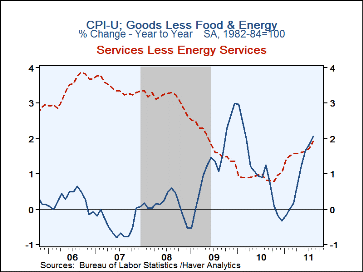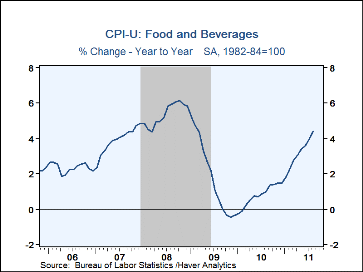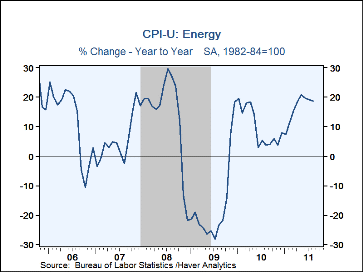 Global| Sep 15 2011
Global| Sep 15 2011U.S. CPI Gain Is Again Surprisingly Strong; Core Increase Stable
by:Tom Moeller
|in:Economy in Brief
Summary
Price inflation held at an elevated rate last month. The overall CPI gained 0.4% following July's 0.5% rise. A 0.2% increase was expected. Despite the August surprise, the three-month gain in prices was a moderate 2.6% (AR), down [...]
Price inflation held at an elevated rate last month. The overall CPI gained 0.4% following July's 0.5% rise. A 0.2% increase was expected. Despite the August surprise, the three-month gain in prices was a moderate 2.6% (AR), down sharply from its 6.2% April peak. Excluding food and beverages, prices gained an expected 0.2% last month after a 0.2% July rise. On a three-month basis, price gains continued firm at 2.9%, near the highest since early-2008.
Higher energy prices again led last month's strength in the CPI with a 1.2% rise. Gasoline prices rose 1.9% (32.4% y/y) after a 4.7% July increase. Food & beverages were again strong, up 0.5%. The y/y increase of 4.4% was its strongest since early-2009. Strength was widespread as cereal prices jumped 1.1% (5.3% y/y), dairy product prices rose 0.9% (9.1% y/y) and prices of meats, poultry & fish rose another 0.4% (8.1% y/y).
For goods alone, core prices firmed by 0.4% (2.2% y/y). Apparel prices again were strong with a 1.1% increase (4.2% y/y). This strength was offset, however, by a modest 0.2% rise in vehicle prices (3.7% y/y). Furniture prices rose 0.3% (0.1% y/y) and broke higher after two months of stability.
Core service prices again rose 0.2% (1.7 y/y). Public transportation costs rose 0.6% (7.2% y/y) after three months of decline. Education costs rose 0.3% (4.4% y/y) but that y/y gain remained below the 6%-to-7% increases in the early 2000s. Medical care service prices rose 0.3% (3.2% y/y) for the fifth straight month. Shelter costs, which are 32% of the CPI, rose 0.2% and the y/y change improved further to 1.6%. Owners equivalent rent of primary residences, a measure not equivalent to other house price measures, rose a firmer 0.2% (1.4% y/y) after stability last year.
The chained CPI, which adjusts for shifts in consumption patterns, rose 0.3% (3.6% y/y). Chained prices less food & energy also rose 0.3% m/m and by 1.7% y/y.
The consumer price data is available in Haver's USECON database while detailed figures can be found in CPIDATA. The expectations figure is the AS1REPNA database.
What's It Worth? Property Taxes and Assessment Practices from the Federal Reserve Bank of Philadelphia is available here.
| Consumer Price Index (%) | Aug | Jul | Jun | Aug Y/Y | 2010 | 2009 | 2008 |
|---|---|---|---|---|---|---|---|
| Total | 0.4 | 0.5 | -0.2 | 3.8 | 1.6 | -0.3 | 3.8 |
| Total less Food & Energy | 0.2 | 0.2 | 0.3 | 2.0 | 1.0 | 1.7 | 2.3 |
| Goods less Food & Energy | 0.4 | 0.3 | 0.5 | 2.1 | 1.1 | 1.3 | 0.1 |
| Services less Energy | 0.2 | 0.2 | 0.1 | 1.9 | 0.9 | 1.9 | 3.1 |
| Energy | 1.2 | 2.8 | -4.4 | 18.5 | 9.6 | -18.2 | 13.7 |
| Food & Beverages | 0.5 | 0.4 | 0.2 | 4.4 | 0.8 | 1.9 | 5.4 |
| Chained CPI: Total (NSA) | 0.3 | 0.1 | -0.1 | 3.6 | 1.5 | -0.1 | 3.7 |
| Total less Food & Energy | 0.3 | 0.1 | 0.1 | 1.7 | 0.7 | 1.5 | 2.0 |
Tom Moeller
AuthorMore in Author Profile »Prior to joining Haver Analytics in 2000, Mr. Moeller worked as the Economist at Chancellor Capital Management from 1985 to 1999. There, he developed comprehensive economic forecasts and interpreted economic data for equity and fixed income portfolio managers. Also at Chancellor, Mr. Moeller worked as an equity analyst and was responsible for researching and rating companies in the economically sensitive automobile and housing industries for investment in Chancellor’s equity portfolio. Prior to joining Chancellor, Mr. Moeller was an Economist at Citibank from 1979 to 1984. He also analyzed pricing behavior in the metals industry for the Council on Wage and Price Stability in Washington, D.C. In 1999, Mr. Moeller received the award for most accurate forecast from the Forecasters' Club of New York. From 1990 to 1992 he was President of the New York Association for Business Economists. Mr. Moeller earned an M.B.A. in Finance from Fordham University, where he graduated in 1987. He holds a Bachelor of Arts in Economics from George Washington University.










